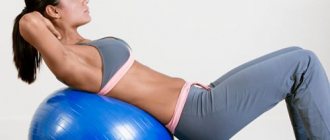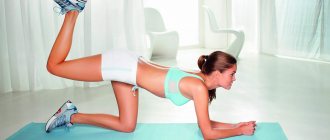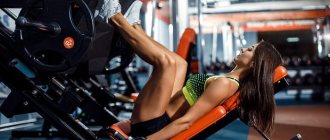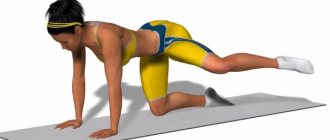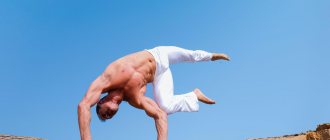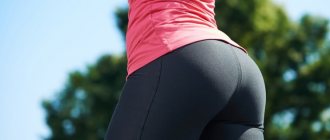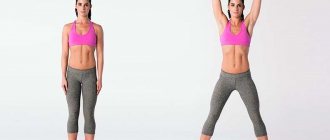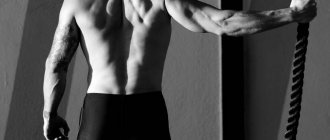Kinds
Weighting agents are fabric bags divided into sectors and filled with weight. This design fits tightly to the leg or arm. The device is secured with Velcro. In stores you can most often find the following types of weighting materials:
- With solid load (stacked). The models are made of dense canvas material, inside of which metal elements of the same weight are placed. Thanks to this, you can effectively vary the load. Another advantage is the strength of the tarpaulin, which practically does not wear out during long-term use.
- With bulk cargo. Simplified version. The base is made of fabric, and various materials are used as cargo: steel balls, sand, salt. More affordable than “hard” models. The disadvantage of soft weights is the inability to vary the loads. In addition, the woven base wears out over time, which leads to loss of filler.
In addition to standard models, there are also weighted gloves and even weight vests. For convenience, some hand accessories are produced in the form of bracelets. This option is popular among girls and beginner athletes.
Types of weights
All weights are divided into two types:
- Bulk (with sand inside). They are cheaper in price, but less practical, since their weight cannot be adjusted.
- Metal (there are metal plates inside them). This type is more expensive, but it is very convenient to use, since its weight can be reduced or added.
Depending on what part of the body the weights need to be attached to, they come in the following varieties:
- Gloves - used in wrestling to enhance the blow. Their weight reaches 12 kg.
- The belt creates a load on the whole body. Can be used during fitness activities. Weight - up to 20 kg.
- Bracelets or cuffs – attached to the ankles or wrists to create extra weight.
- Vests - Originally used by the military to increase their stamina. Over time, they became popular among people who are seriously involved in sports. Weight - up to 48 kg.
This is interesting: Smoothies: benefits and harms, how to make at home
Efficiency
Additional weights are used to increase loads and improve athletic performance. Let's look at the advantages of using weights:
- Intensive weight loss. Weight accessories create resistance to muscle work, which allows you to burn subcutaneous fat faster. For example, when running with weights on your legs, calorie consumption increases by 15–20%.
- Increased endurance. Along with the load on the body, the heart rate increases. As a result, the heart muscles are strengthened, and the athlete becomes less susceptible to long-term exhausting training.
- Shaping a sporty silhouette. When using weights for the lower extremities, the hips and buttocks are strengthened. When wearing wrist weights, your shoulders and back are well worked out. As a result, the muscles become toned and the figure becomes toned.
- Overcoming stagnation. Many athletes, having reached a “plateau”—the point at which progress stops—drastically change their training program in order to “shock” the muscles that have adapted. Weighted cuffs allow you to achieve the same effect with your usual exercises.
Of course, you won’t be able to pump up large amounts of muscle with weights. For these purposes, power projectiles are used. But it is possible to create additional load in aerobic training and improve results in body shaping.
Walking and running with weights for weight loss
Walking and running with weights on your legs not only helps you lose weight, but also strengthens your heart muscle and respiratory system, and also stimulates metabolic processes in the body.
During this type of cardio training, the athlete works the soleus muscle, the muscles of the calves, the front and back of the thigh, the abs, the ankle, as well as the muscular corset that supports the spinal column.
The advantages of the weighted loads under consideration include:
- minimum time spent on cardio training to obtain maximum results;
- comprehensive training of the main muscle groups;
- significant acceleration of the fat burning process (calorie consumption increases up to 5 times).
Despite the proven effectiveness of walking and running for weight loss, this type of exercise has a number of disadvantages, which must be taken into account in advance of training:
- the need to prepare muscles (for this, fitness trainers recommend that beginners start running regularly about 6 months before the expected introduction of weights into the training program);
- the presence of contraindications (the main ones include hypertension of degrees 2 and 3, diseases of the heart and skeletal system of the body);
- negative impact on joints;
- high risk of injury (possible in case of incorrect selection of sports equipment).
Weights of various types are the most versatile sports equipment. Depending on the result that the athlete wants to achieve with his training, he should fix additional weights on his arms or legs, and then perform standard exercises aimed at working specific muscle groups.
With regular exercise, the results from this type of training will be noticeable after 1-2 months of training at home.
Weight selection
Supplement your workouts with accessories gradually. As a rule, the minimum weight of weights starts from 0.5 kg. During the first month, exercise with such weights. When the muscles get used to it, add another 500 g. Gradually you will increase the weight of the accessories to 5–6 kg, which corresponds to the loads of trained athletes.
Beginners need to first master the exercise technique under the supervision of a trainer, and only then “connect” weights.
Speed exercises, such as running, are recommended to be performed with minimal equipment (0.5–1 kg). For low-intensity elements aimed at working out muscle relief and strengthening them, you should choose weights weighing from 2 to 4 kg.
5 Effective Cardio Exercises With Leg Weights
If your goal is to quickly lose weight and tone your muscles, we recommend that you regularly perform the elements below.
Running with high knees and shin overload
We attach weights to our ankles and straighten up. Bend your arms and keep your forearms parallel to the floor. We alternately raise our knees and try to touch our palms. We move energetically, without pauses.
You can do it in one place or run around the gym. Continue for 1-2 minutes.
Then we bring our hands behind our backs and press them to our buttocks. We bend our legs one by one and try to reach our heels to our palms. We perform the overlapping quickly, for 1–2 minutes.
Climber
Place the weight firmly on your ankles and lower yourself into a plank position. The pelvis is slightly raised. Sharply pull the knee towards the opposite shoulder. We quickly return to the starting position and at the same time repeat the movement with the other knee. We move without pauses, at a fast pace, for 1 minute.
Jumping onto a plyo box
We attach the weights to the shins, stand facing the box (height 60–70 cm). We push off with our feet and jump onto the platform. When taking off, we help ourselves with a wave of our hands. Without delay, with a slight bounce back we return to the original position. Repeat for 1-2 minutes.
Jumping rope
We attach the weight cuffs to the ankles and take the jump rope in our hands. We jump for 3-4 minutes. We periodically change the jumping technique: on one leg, back and forth, with acceleration, with a double twist of the rope, and so on. The main thing is variety of movements.
Classic running
A simple and effective exercise for weight loss. In combination with additional weights, it allows you to quickly reduce fat and strengthen muscles and ligaments.
Beginners are not recommended to run with weights, as this overloads unprepared leg joints. First, you should master the technique of movements and practice acceleration and running uphill. Only after this can you gradually begin to use the cuffs.
Complexes of exercises with weights
Using this sports equipment, you can pump up the muscles of the arms, legs, buttocks, abdomen, and chest. Below we will consider a system of exercises for them.
Exercises for legs, abdomen and buttocks
These are various leg lifts and swings. Weights are attached to the ankles, above sports shoes.
Removal of limbs to the side
Stand up straight, place your hands on your belt. Select your supporting leg and slowly move in the opposite direction, bending your other leg and trying to maintain your balance. Then change your supporting leg. Do abductions 10–15 times for each limb, gradually increasing the load.
Lifting the leg from a lying position
Lie on the floor on your right side. Place your curved right arm on the floor. Extend your other hand in front of you. Place the foot of your left curved leg on the floor. Make small swings with your right foot. For each leg, repeat the exercise 10–15 times.
Find out the most effective exercises for your legs and buttocks.
Kneeling Leg Raise
Get on your knees, place your hands on the floor. Extend your right leg. Her fingers should touch the floor. Do not bend your torso. From this position, lift your leg as far as possible 10–15 times. Repeat the same for your left leg.
Taking the leg back
Stand up straight, put your hands on your waist. Slowly move one leg back, then the other, without bending forward. Perform these actions 10–15 times for each limb.
Leg swings while lying down
Lying on your back, lift one leg 90°, then the other (10–15 times). Perform the same swings while lying on your side.
For chest and arms
This group consists of the following exercises.
Scissors for hands
Stand straight, extend your arms parallel to the floor, tense them. Do scissoring 20 times. After this, raise your arms above your head and repeat these steps the same number of times. “Scissors” are done in 2-3 approaches.
"Mill"
Stand straight with your feet shoulder-width apart. Lean forward 90°. Raise your right hand up and lower your left hand down. Rotate your hands, with your right hand touching the toe of your left foot, and your left hand touching the toe of your right foot. Do the exercise slowly at first, gradually, after which you can speed up.
"Hammer"
Take light dumbbells in your hands. Stand up straight. Place your arms close to your body. Raise the right dumbbell one by one to shoulder level, then the left. Do lifts 10–15 times on both limbs.
This is interesting: Have you seen such big cats?
Jumping with arms raised
Stand up straight, lower your arms along your body. As you jump, spread your legs and simultaneously raise your arms above your head. Repeat steps 10–15 times.
You will also be interested in learning about the best exercises for men and women with a medicine ball, a barbell plate, and kettlebells.
Walking and running for weight loss
Athletes often practice race walking and running to lose weight. Let's look at how to perform race walking correctly:
- choose comfortable clothes and shoes;
- walk short but fast;
- don’t slouch, keep your stomach pulled in;
- bend your arms at the elbows, move them rhythmically, in accordance with the speed of your walking;
- breathing should be even;
- do not stop walking abruptly.
To begin with, it will be enough to conduct such training 4 times a week for 20 minutes, gradually increasing their duration.
Did you know? There are many types of race walking: Nordic walking (with poles similar to skiing), walking on stairs (the prototype of step aerobics), as well as mass walking, in which thousands of people cover long distances at the same time (it is especially popular in Japan).
As for running, you can do it in the morning (you will recharge your batteries for the whole day) or in the evening (as a good release after a hard day at work). Before your morning run, drink a glass of water and have breakfast 15-30 minutes after you finish.
To get the maximum effect from an evening run, it is recommended to have dinner 2 hours before it. You need to start running for short distances first, gradually increasing its duration. Be sure to choose the type of running that suits you (jogging, shuttle, sprint).
A set of exercises to strengthen the abs, thighs and buttocks
Before starting classes, do a simple warm-up: jog at an easy pace and gently stretch your muscles.
- We attach weights to our shins and stand up straight. We place one hand on the back of a chair or any other stable object. We perform swing abductions to the side. We do 20 movements and change legs. After this, we repeat the exercise with moving the limbs forward and backward. Another 20 times.
- We get on all fours, weights on our feet. Then we lower our forearms to the floor. From this position, straighten one leg and perform upward swinging movements. In the lower phase, do not lower the toe of the foot to the floor. We try not to bend the knee. At the top point, squeeze the buttocks as much as possible. Repeat 20 times and change sides.
- We stand in the “on all fours” position, the cuffs are on the ankles. Smoothly raise your right knee and move it to the side. We try to bring the thigh parallel to the floor. Slowly lower your leg, but do not place your knee on the floor at the lowest point. We perform 20 leads and change sides.
- We remain on all fours. Straighten your right leg at an angle of 45° back and place its toe on the floor. Without bending the knee, with a swinging circular motion we move the right foot behind the left, touch the floor and immediately return to the starting position. We do 20 movements, then change legs and repeat.
- We fasten the cuffs to the shins, lie on your back and bring your hips together. We keep our heels suspended. From this position, we raise our legs vertically, at the same time we push our pelvis up, taking the “birch tree” pose. We immediately return to the starting position. Repeat 20 times.
- Lying on your back, pull your knees to your chest and clasp them with your arms. At the same time, we spread the upper and lower limbs to the sides. The pose should resemble a star. We quickly return to the starting position and repeat. We make 20 dilutions.
Perform the presented plan in 2 circles. Pauses between elements are minimal - 10–15 seconds. Rest between circles - 2-3 minutes.
Before starting your workout, as a warm-up, you can use one of the cardio exercises discussed above. Complete the training by jumping rope without weights (7-10 minutes). To achieve results, exercise 3-4 times a week.
Leg swings with weights for the buttocks
Difficulty is high. A very effective exercise for the gluteal muscles, the abdominal muscles are involved.
- Starting position - rest your hands on the floor, fingers joined together, legs bent at the knees, knees resting on the floor.
- Slowly swing your right leg until it is completely straightened. We return it to its original position.
We repeat the movement 10-15 times, and then do it with the other leg. You can perform each swing with either your left or right foot.
Learn more from the video:
How to make your own leg weights
If you don't want to spend money, sew the cuffs yourself. You will need thick, strong fabric, a zipper with a lock, a Velcro strip, a metal ring and filler:
- Cut the fabric into two pieces 50 cm long and 30 cm high. Then sew them together, leaving the top edges free. It should look like a handbag.
- Sew a Velcro strip on the outside. At the same time, half of it remains free. It is the free part that will tighten the weighting material.
- Sew a ring on the opposite end from the Velcro.
- Sew a zipper into the upper sides of the “bag”.
- Divide the surface of the workpiece into several equal compartments, stitch on a machine, forming “pockets”.
- Place the filling inside and close the zipper. You can start training!
Recommendation: if you are doing weights only for the legs, reduce the height of the weight to 12-15 cm so that when applied to the lower leg it does not put pressure on the calf muscles.
Contraindications
There are diseases for which it is undesirable to train with the use of additional weights:
- phlebeurysm;
- recovery period after surgery or injury;
- muscle and ligament sprains;
- joint dislocations;
- spine pathologies;
- diseases of the cardiovascular and respiratory systems.
If health problems are diagnosed, the athlete is obliged to inform the coach, who will decide on the admissibility of using weights.
